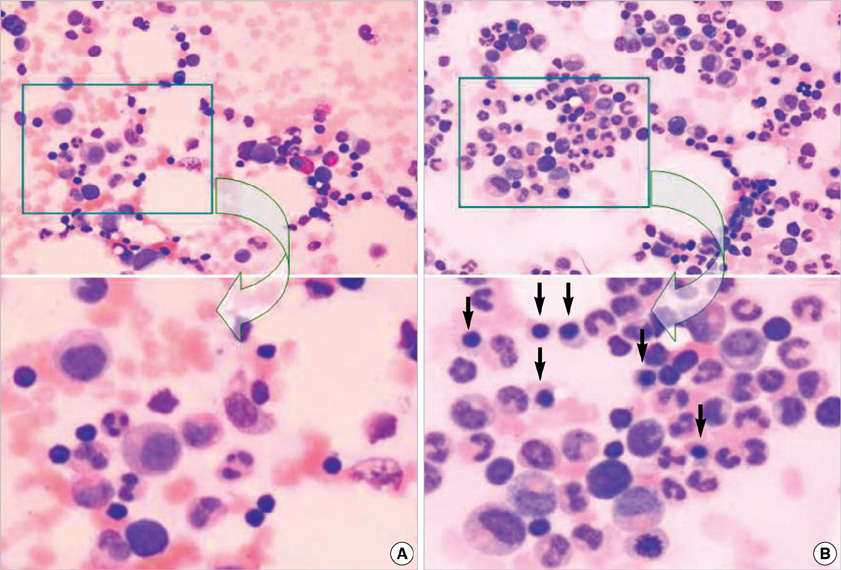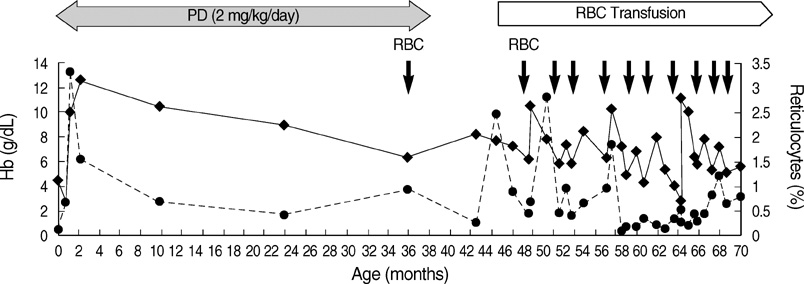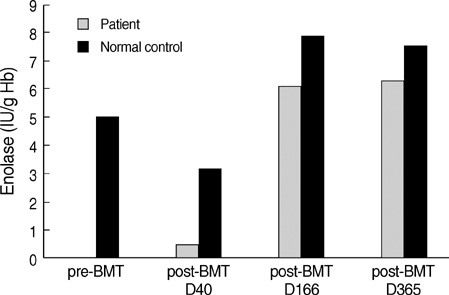J Korean Med Sci.
2010 Apr;25(4):626-629. 10.3346/jkms.2010.25.4.626.
Normalization of Red Cell Enolase Level Following Allogeneic Bone Marrow Transplantation in a Child with Diamond-Blackfan Anemia
- Affiliations
-
- 1Pediatric Oncology Center, National Cancer Center, Goyang, Korea. thadghim@gmail.com
- 2Department of Pediatrics, Inje University Haeundae Paik Hospital, Busan, Korea.
- 3Department of Pediatrics, Chungnam University Hospital, Daejeon, Korea.
- 4Department of Diagnostic Laboratory Medicine, National Cancer Center, Goyang, Korea.
- KMID: 1792936
- DOI: http://doi.org/10.3346/jkms.2010.25.4.626
Abstract
- We describe a girl with Diamond-Blackfan anemia with accompanying red cell enolase deficiency. At the age of 9 yr old, the patient received allogeneic bone marrow transplantation from her HLA-identical sister who had normal red cell enolase activity. While the post transplant DNA analysis with short tandem repeat has continuously demonstrated a stable mixed chimerism on follow-up, the patient remains transfusion independent and continues to show a steady increase in red cell enolase activity for over two and a half years following bone marrow transplantation.
Keyword
MeSH Terms
Figure
Reference
-
1. Da Costa L, Willig TN, Fixler J, Mohandas N, Tchernia G. Diamond-Blackfan anemia. Curr Opin Pediatr. 2001. 13:10–15.2. Wang WC, Mentzer WC. Differentiation of transient erythroblastopenia of childhood from congenital hypoplastic anemia. J Pediatr. 1976. 88:784–789.
Article3. Sung HJ, Kim SJ, Lee JH, Lee G, Lee KA, Choi CW, Kim BS, Kim JS. Persistent anemia in a patient with diffuse large B cell lymphoma: pure red cell aplasia associated with latent Epstein-Barr virus infection in bone marrow. J Korean Med Sci. 2007. 22:Suppl. S167–S170.
Article4. Beutler E, Blume KG, Kaplan JC, Löhr GW, Ramot B, Valentine WN. International Committee for standardization in Haematology: recommended methods for red-cell enzyme analysis. Br J Haematol. 1977. 35:331–340.
Article5. Wallin JM, Buoncristiani MR, Lazaruk KD, Fildes N, Holt CL, Walsh PS. TWGDAM validation of the AmpFISTR blue PCR amplification kit for forensic casework analysis. J Forensic Sci. 1998. 43:854–870.
Article6. Boulard-Heitzmann P, Boulard M, Tallineau C, Boivin P, Tanzer J, Bois M, Barriere M. Decreased red cell enolase activity in a 40-year-old woman with compensated haemolysis. Scand J Haematol. 1984. 33:401–404.
Article7. Lachant NA, Jennings MA, Tanaka KR. Partial erythrocyte enolase deficiency: a hereditary disorder with variable clinical expression. Blood. 1986. 65:55A.8. Perdahl EB, Naprstek BL, Wallace WC, Lipton JM. Erythroid failure in Diamond-Blackfan anemia is characterized by apoptosis. Blood. 1994. 83:645–650.
Article9. Gazda H, Lipton JM, Willig TN, Ball S, Niemeyer CM, Tchernia G, Mohandas N, Daly MJ, Ploszynska A, Orfali KA, Vlachos A, Glader BE, Rokicka-Milewska R, Ohara A, Baker D, Pospisilova D, Webber A, Viskochil DH, Nathan DG, Beggs AH, Sieff CA. Evidence for linkage of familial Diamond-Blackfan anemia to chromosome 8p23.3-p22 and for non-19q non-8p disease. Blood. 2001. 97:2145–2150.
Article10. Cmejla R, Cmejlova J, Handrkova H, Petrak J, Pospisilova D. Ribosomal protein S17 gene (RPS17) is mutated in Diamond-Blackfan anemia. Hum Mutat. 2007. 23:1178–1182.
Article11. Quigley JG, Gazda H, Yang Z, Ball S, Sieff CA, Abkowitz JL. Investigation of a putative role for FLVCR, a cytoplasmic heme exporter, in Diamond-Blackfan anemia. Blood Cells Mol Dis. 2005. 35:189–192.
Article12. Willig TN, Pérignon JL, Gustavsson P, Gane P, Draptchinskaya N, Testard H, Girot R, Debré M, Stéphan JL, Chenel C, Cartron JP, Dahl N, Tchernia G. The DBA Working Group of Societe d'Immunologie Pediatrique (SHIP). High adenosine deaminase level among healthy probands of Diamond Blackfan anemia (DBA) cosegregates with the DBA gene region on chromosome 19q13. Blood. 1998. 92:4422–4427.13. Tanphaichitr VS, Suvatte V, Issaragrisil S, Mahasandana C, Veerakul G, Chongkolwatana V, Waiyawuth W, Ideguchi H. Successful bone marrow transplantation in a child with red blood cell pyruvate kinase deficiency. Bone Marrow Transplant. 2000. 26:689–690.
Article14. Liesveld JL, Rothberg PG. Mixed chimerism in SCT: conflict or peaceful coexistence? Bone Marrow Transplant. 2008. 42:297–310.
Article15. Wu CJ, Gladwin M, Tisdale J, Hsieh M, Law T, Biernacki M, Rogers S, Wang X, Walters M, Zahrieh D, Antin JH, Ritz J, Krishnamurti L. Mixed haematopoietic chimerism for sickle cell disease prevents intravascular haemolysis. Br J Haematol. 2007. 139:504–507.
Article16. Walters MC, Patience M, Leisenring W, Rogers ZR, Aquino VM, Buchanan GR, Roberts IA, Yeager AM, Hsu L, Adamkiewicz T, Kurtzberg J, Vichinsky E, Storer B, Storb R, Sullivan KM. Stable mixed hematopoietic chimerism after bone marrow transplantation for sickle cell anemia. Biol Blood Marrow Transplant. 2001. 7:665–673.
Article
- Full Text Links
- Actions
-
Cited
- CITED
-
- Close
- Share
- Similar articles
-
- Genetics and genomics of bone marrow failure syndrome
- Two Cases of Generalized Vitiligo after Allogeneic Stem Cell Transplantation
- Unrelated Cord Blood Transplantation Using Non-TBI Conditioning Regimen in a Child with Fanconi Anemia
- Successful allogeneic bone marrow transplantation for childhood-onset refractory anemia with ringed sideroblasts
- Acquired Hypopituitarism in Diamond-Blackfan Anemia




